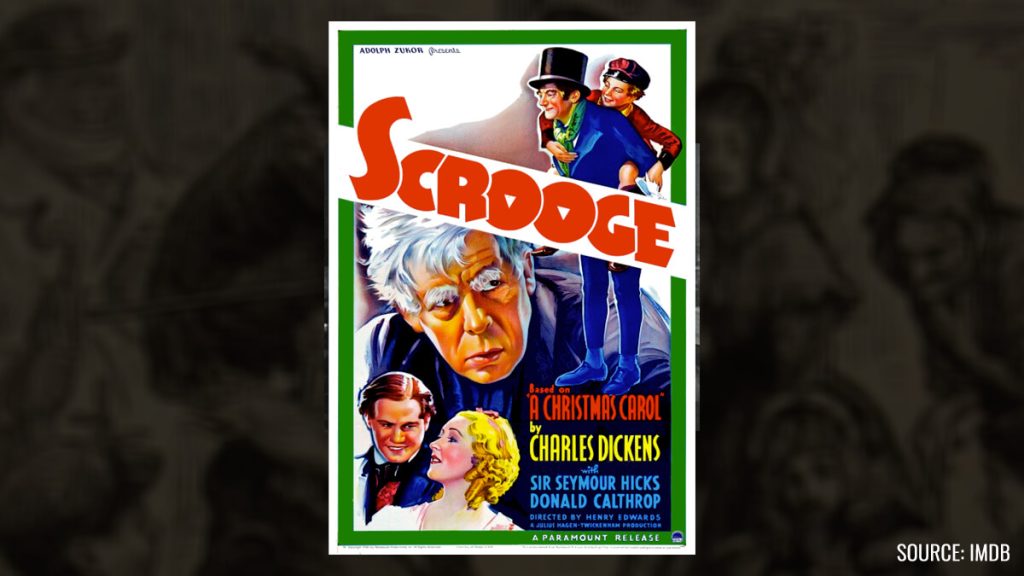Though sound would arrive in Hollywood in 1928, it wouldn’t be until 1935 ’til someone made the first full-length “talking picture” version of “A Christmas Carol.”
Produced in the U.K. at Twickenham Studios, “Scrooge” is a relatively faithful screen adaptation of Charles Dickens’ classic holiday tale. This film’s one main claim to fame is that the title role is played by Sir Seymour Hicks. Who had already portrayed Ebenezer in a 1913 silent film version of “A Christmas Carol.” Not to mention playing Scrooge on stage over 2000 times (Or so said the press releases that accompanied the American release of this Henry Edwards film).
Of course, given that “A Christmas Carol” is basically a ghost story, it’s always interesting to see how the filmmakers go about portraying the various spirits that appear in each version of this film. In the case of Marley’s Ghost … While Jacob’s face does briefly appear on the house’s door knocker …
That’s the only time in the picture that you actually get to see Scrooge’s old partner. In the scene where Jacob confronts Ebenezer in front of the fireplace, it’s all done as a disembodied voice. So, in essence, Sir Seymour is working alone in an empty room. And it’s a real tribute to Hicks’ talent that this scene is as affecting as it is. This version of Scrooge seems genuinely spooked to be visited by this spirit from his past.
As for the rest of the ghosts in the film, the Ghost of Christmas Present is portrayed as a white filmy outline …
… While the Ghost of Christmas Future is done more as a stylized black shadow.
Only the Ghost of Christmas Present is portrayed by an actual actor. As played by Oscar Ashe, this Christmas spirit seems okay.
Though — to be fair — I was watching a fairly abbreviated version of this film. And several other scenes that would have shown Ashe & Hicks working together (EX: A sequence where Scrooge & the Ghost of Christmas Present were to have journeyed beyond the streets of London, to see how sailors out at sea & workers high atop a lighthouse celebrated the holiday) had been clipped out of my 60-minute-long version of “Scrooge.”
Given some of the other interesting choices that Henry Edwards made while helming this film — like journeying to the Lord Mayor’s mansion and showing us all of the elaborate preparation that went into creating a Christmas feast for all the members of London high society, or the heart-breaking moment in the movie where Bob Crachit sits with the body of the now-dead Tiny Tim — …
… It would have been interesting to see how the original full-length version of “Scrooge” would have played. Though one wonders if that cut of the movie even exists today. Given that — when Paramount Pictures acquired the rights to show this Twickenham Studios production in the U.S. — it reportedly chopped at least 5 minutes of footage out of the film.
Mind you, Amazon.com is currently selling several different versions of this 1935 release. One DVD (I.E. The one that I bought) lists a 60-minutes running time, while another version of “Scrooge” (I.E. The version that I should have bought) lists a running time of 78 minutes. So perhaps — if you shop carefully — you can do a better job than I did at getting to see this entire film.
For — based on its atmospheric sets (London in the 1840s is portrayed as this incredibly dark & murky place) as well as its judicious use of special effects (At one point, the camera rises up over this elaborate miniature, which reveals what the city must have looked like on Christmas night) — …
… “Scrooge” actually looks pretty good for a first try at making a full-length “talking picture” version of “A Christmas Carol.”
Mind you, just three years later, Hollywood’s mightiest studio — Metro Goldwyn Mayer — would take a stab at translating Charles Dickens’ classic holiday tale to the big screen.
